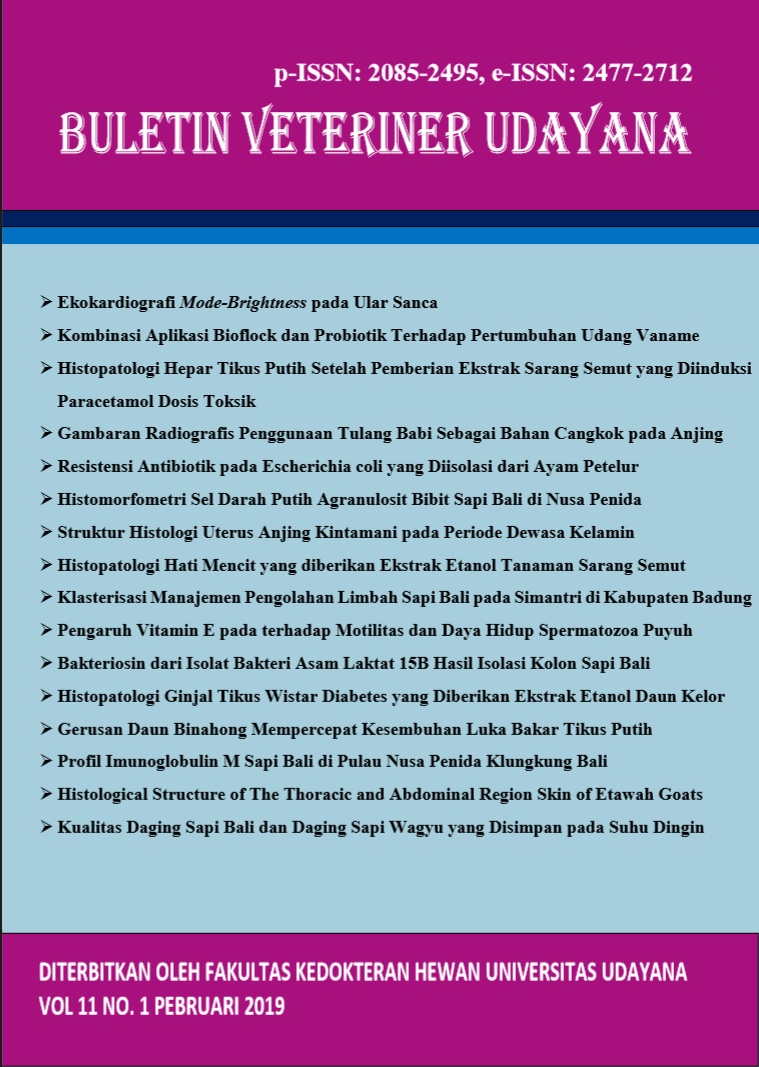THE IMPACT OF BIOFLOCKS APPLICATION COMBINED WITH PROBIOTICS ON THE GROWTH PERFORMANCE OF WHITE LEG SHRIMP
Abstract
Intensive shrimp farming was found many disease problems such as bacteria, viruses, or the presence of co-infection. One of the diseases was caused by viruses and often a major problem in the shrimp farming system was IMNV (Infectious Myonecrosis Virus). Bioflok technology was one alternative that can be done to overcome the problem of cultivation waste. Even able to provide more benefits because in addition to reducing inorganic nitrogen waste, can also provide additional feed for fish cultivation so as to improve the growth and efficiency of feed. The addition of probiotics in biofloc was also expected to improve the growth performance of white shrimp. This study was aimed to evaluate the use of bioflock combined with probiotics on the growth performance of vaname shrimp (Litopenaeus vannamei). This research will be conducted for 5 months. The treatment provided is the addition of commercial probiotics in culture medium with biofloc system and fermented pellet feed with various commercial probiotics, ie probiotics I + biofloc (1), probiotics II + biofloc (2), probiotics III + biofloc (3), positive control (biofloc culture medium and without the addition of commercial probiotics) (4), and negative control (without probiotics + without biofloc) (5). The results obtained for growth performance ie on treatment 2 with 80% of survival rate, the value of daily growth rate of 4.9 and the value of feed conversion ratio of 1.41.
Downloads
References
Aly SM, Mohamed MF, John G. 2008. Effect of probiotics on the survival, growth and challenge infection in Tilapia nilotica (Oreochromis niloticus). Aquaculture Res. 39: 647-656.
Avnimelech Y. 1999. Carbon/nitrogen ratio as a control element in aquaculture system. Aquaculture. 176: 227-235.
Azim ME, Little DC. 2008. The biofloc technology (BFT) in indoor tanks: water quality, biofloc composition, and growth and welfare of Nile tilapia(Oreochromis niloticus). Aquaculture. 283: 29-35.
Burford MA, Thompson PJ, McIntosh RP, Bauman RH, Pearson DC, 2004. Nutrient and microbial dynamics in high intensity, zero-exchange shrimp ponds in Belize. Aquaculture. 219: 393-411.
Crab, R., Y. Avnimelech, T. Defoirdt, P. Bossier, and W. Verstraete. 2007. Nitrogen Removal Techniques in Aquaculture for Sustainable Production. Aquaculture. 270: 1-14.
Daniels CL, Merrifield DL, Boothroyd DP, Davies SJ, Factor JR, Arnold KE. 2010. Effect of Dietary Bacillus spp. and Mannan Ologosaccharides (MOS) on European Lobster (Homarus gammarus L) Larvae Growth Performance, Gut Morphology and Gut Microbiota. Aquaculture. 304: 49-57.
De Schryver P, Carb R, Derfoirth P, Boon N, Verstrete W. 2008. The basics of bio-flocs technology: The added value for aquaculture. Aquaculture. 277: 125-137.
Hargreaves JA. 2006. Photosynthetic suspended-growth systems in aquaculture. Aquac. Eng. 34: 344-363.
Liu CH, Chen CJ. 2004. Effect of ammonia on the immune response of white shrimp Litopenaeus vannamei and its susceptibility to Vibrio alginolyticus. Fish and Shellfish Immunol. 16: 321-334.
Nayak SK. 2010. Probiotics and Immunity: A Fish Perspective. Review. Fish and Shellfish Immunol. 29: 2-14.
Poulos BT, Tang KFJ, Pantoja CR, Bonami JR, Lightner DV. 2006. Purification and characterization of infectious myonecrosis virus of penaeid shrimp. J. Gen. Virol. 87: 987-996.
Senapin S, Phewsaiya K, Briggs M, Flegel TW. 2007. Outbreaks of infectious myonecrosis virus (IMNV) in Indonesia confirmed by genome sequencing and use of an alternative RT-PCR detection method. Aquaculture. 266: 32-38.
Teixeira-Lopes MA, Vieira-Girão PRN, da Cruz Freire JE, Rocha ÍRCB, Costa FHF, Rádis-Baptista G. 2011. Natural Co-infection With Infectious Hypodermal and Hematopoietic Necrosis Virus and Infectious Myonecrosis Virus in Litopenaeus vannamei in Brazil. Aquaculture. 312: 212-216.
Verschuere L, Rombaut G, Sorgeloos P, Verstraete W. 2000. Probiotic Bacteria as Biological Control Agents in Aquaculture. Microbiol. Mol. Biol. Rev. 64(4): 655-671.
Wang YB. 2007. Effect of Probiotics on Growth Performance and Digestive Enzyme Activity of The Shrimp Penaeus vannamei. Aquaculture. 269: 259-264.
Watson AK, Kaspar H, Lategan MJ, Gibson L. 2008. Probiotics in aquaculture: The need, principles and mechanisms of action and screening processes. Aquaculture. 274: 1-14.
Widanarni, Sukenda, Setiawati M. 2008. Bakteri Probiotik dalam Budidaya Udang: Seleksi, Mekanisme Aksi, Karakterisasi dan Aplikasinya Sebagai Agen Biokontrol. J. Ilmu Pertanian Indonesia. 13(2): 80-89.
Zhang J, Liu Y, Tian L, Yang H, Liang G, Xu D. 2012. Effects of Dietary Mannan Oligosaccharide on Growth Performance, Gut Morphology and Stress Tolerance of Juvenile Pacific White Shrimp Litopenaeus vannamei. Short Communication. Fish and Shellfish Immunol. 33(4): 1027-1032.





